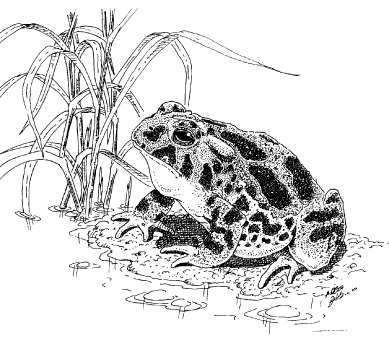|
Frogs and Toads | Frog Toad Overview | Frog Toad Damage Assessment | Frog Toad Damage Management | Frog Toad Resources | Frog Toad Acknowledgments | ICWDM | Wildlife Species Information |

Figure 1. Great Plains toad, Bufo cognatus.
Contents |
Identification
Frogs and toads are amphibians with four legs and no tail. They may have skin that is smooth and moist or dry and warty, but they have no scales or claws. The front legs are short, but the hind legs are muscular and elongated for hopping or jumping. The popular distinction between frogs and toads is somewhat artificial. Basically, toads are a particular group of frogs. Throughout this chapter, the term frog will be used to include toads. North American frogs range in body size from the 11/16-inch (1.7-cm) little grass frog to the 8-inch (20-cm) bullfrog.
General Biology, Reproduction, and Behavior
Although some species spend most of their adult lives away from water, most frogs native to North America must return to water to lay eggs. Some species breed during the cooler winter and spring months, whereas others breed during the warmer months. Following rain, males begin calling from breeding sites. Each species has its own distinctive call, and females respond only to the calls of their own species. Several recordings of frog calls are available, and four are listed at the end of this chapter.
Eggs are fertilized by the male as they are released by the female. Hatching occurs a few days later. The aquatic tadpole stage may last as little as 2 to 3 weeks in some species of spadefoots, or as long as 2 years in some northern populations of bullfrogs.
Frogs are typically most active at night. Some species aggregate around artificial lights and feed on the insects attracted there. Frogs are an important component of the vertebrate food chain and are consumed by a variety of predators, including fish, snakes, turtles, wading birds, raptors, skunks, and raccoons. Individuals of many species may live 12 to 15 years, but life expectancy is much shorter in the wild.
|
Frogs and Toads | Frog Toad Overview | Frog Toad Damage Assessment | Frog Toad Damage Management | Frog Toad Resources | Frog Toad Acknowledgments | ICWDM | Wildlife Species Information |
Range
At least 85 species of frogs are native to the United States, and there are three well-established exotic species. There is no part of the country that is not home to at least a few species.
Habitat
Frogs occur in almost all non-marine habitats. “True” frogs (genus Rana) and treefrogs predominate in the more humid east. In the drier Great Plains and western regions, toads and spadefoots are typically more numerous. Whereas some species are seldom found far from permanent water, others return to water only seasonally to breed. Some desert species spend most of their time beneath ground, venturing to the surface only following rains.
Food Habits
Most frogs have a two-phased life cycle, including an aquatic larval form (tadpole) and a terrestrial or semi-aquatic adult form. Tadpoles are primarily herbivorous, feeding on algae and decaying organic matter. Adults, on the other hand, are carnivorous, consuming almost any prey that can be overpowered. Although the diet consists primarily of insects, crayfish, and other invertebrates, larger frogs occasionally take snakes, other frogs, fish, mice, and small birds. In natural habitats, fish usually comprise less than 5% of the diet of the bullfrog. On fish farms, as many as 30% of bullfrogs have been found to contain fish.
Paul E. Moler. Wildlife Biologist. Florida Game and Fresh Water Fish Commission. Wildlife Research Laboratory. Gainesville, Florida 32601
